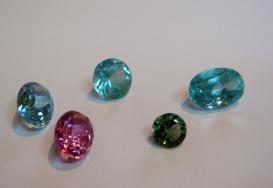It has been argued persuasively that we should see the art of the miniaturist as being closely related to the art of the goldsmith—with the painted "jewel" of the miniature developing from the translucent enamels on an engraved ground used by earlier and contemporary goldsmiths. Indeed, there is a close affinity between Nicholas Hilliard’s art of portrait miniature painting and goldsmithery and jewellery. His Treatise’s famous section devoted to precious stones reflects this idea, a section specifically concerned with the relationship of those stones to the colors which he uses in the miniatures, colors which can be seen as surrogates for the stones themselves in the same way that enamels were.
Color, light, and shadow—these three aspects of how to render the natural world into paint are closely related: it is precisely the purported complexity of the relationship that demanded, at least in the view of early miniature painters, a painting technique that took care not to intermingle light and shadow with the color itself—that is: not to create three-dimensional chiaroscuro-effects and, above all, not to let color be "corrupted" by shadows or "mixed" with other colors. This project looked at portrait miniature painting and seventeenth-century color theory.

